KitchenIQ 50009 Knife Sharpener In-depth Review
The KitchenIQ knife sharpener is relatively easy to use and has great build quality, but it didn't perform well in our sharpness tests.
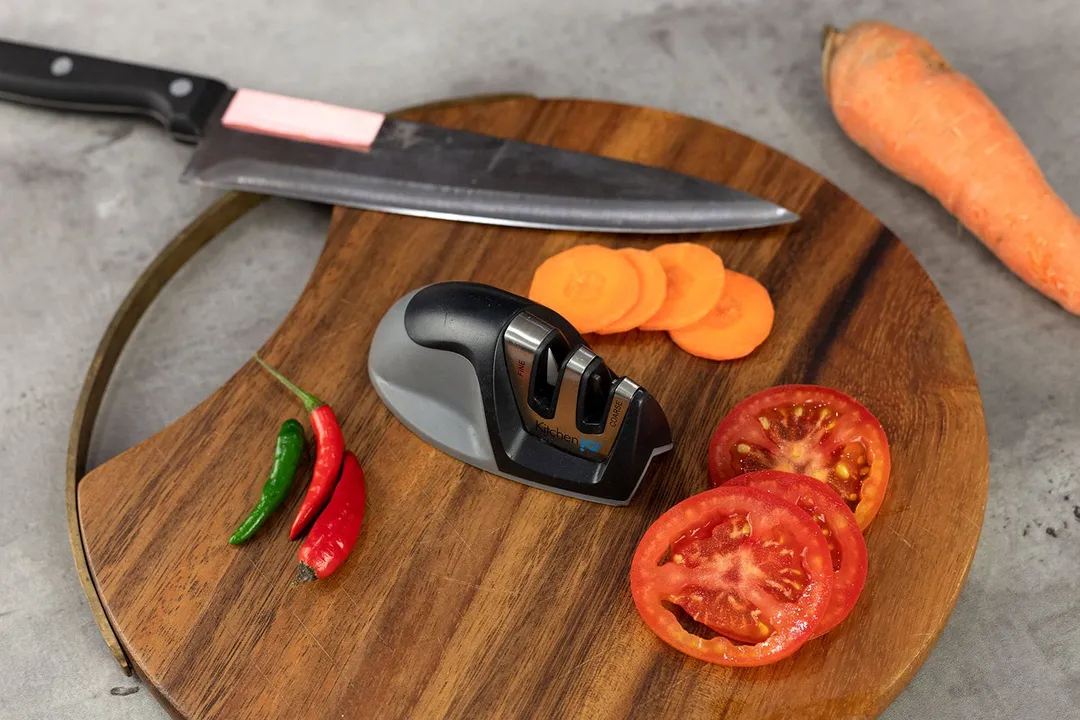
Overall Verdict
The KitchenIQ Knife Sharpener is a sturdy, compact, and affordable device. However, it’s not the sharpest knife in the drawer — so to speak — nor will it create one.
It may work if you’re looking for an okay sharpener to use on the go. But for everyday sharpening in the kitchen, we recommend using a more substantial device.
Things We Like
- Easy storage
- Affordable price
- Base works on both counter edge and flat surfaces
- Simple, sturdy design
Things We Don’t Like
- Awkward small size
- Long sharpening time
The KitchenIQ 50009 has been featured on many sharpener rating lists, and we also couldn’t help but notice its fifty thousand positive reviews on Amazon. The device is cheap, which is surely one of the reasons why, but is there more to it? Naturally, this was one of the first handheld sharpeners we bought to test out in our search for the best sharpeners for kitchen knives.
Key Specs
Where to Buy Price at publication $10.67
*You help support HealthyKitchen101's product testing and reviews by purchasing from our retail partners.
Compared to Other Manual Knife Sharpeners
4.3 Performance
The KitchenIQ failed the speed test and offered mediocre results in all other performance tests. Its rather small sharpening elements will sharpen your knives enough that you’ll be able to feel the difference, but not significantly. It will shave a lot of metal off your knives and leave a barely passable edge.
1.0 Sharpening Time to Cut a Lemon
The KitchenIQ took 215 seconds, or more than 3 minutes to sharpen a knife to the point where it could cut through a big lemon in one single swipe. This may not sound like a terribly long time, but we generally expect faster results from handheld sharpeners. In fact, similar one-stage or two-stage devices take less than half that time to get to the same level. For example, it was 105 seconds for the Sharpal, and 65 seconds for the SunrisePro.
6.0 Maximum Sharpness Achieved
An additional 3 minutes on the KitchenIQ took the test knife from the lemon to the ripe tomato level, and that was its peak sharpness with this device.
Though this is below what most sharpeners can achieve, at this level, the knife’s still capable of most cutting tasks, save for perhaps precision cutting and thin slicing.
We conducted this test several times over the span of six months and used the device in our kitchen throughout that time. The results were consistent, so at least we can conclude that its abrasives will take a long time to wear down.
6.0 Material Retention


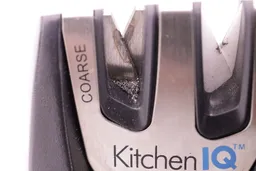
Since its tungsten carbide blades do most of the sharpening, the KitchenIQ peels off more steel from the blade than do most other multi-stage sharpeners. It produces more dust than coarse swarf, suggesting that it acts more like a grinder rather than a serious peeler. This suspicion is confirmed by the relatively fine edges it creates. This was true even when we deliberately applied more force while pulling the knife through.
Unfortunately, the extra pressure didn’t help much with improving the knife’s sharpness.
6.5 Edge Smoothness
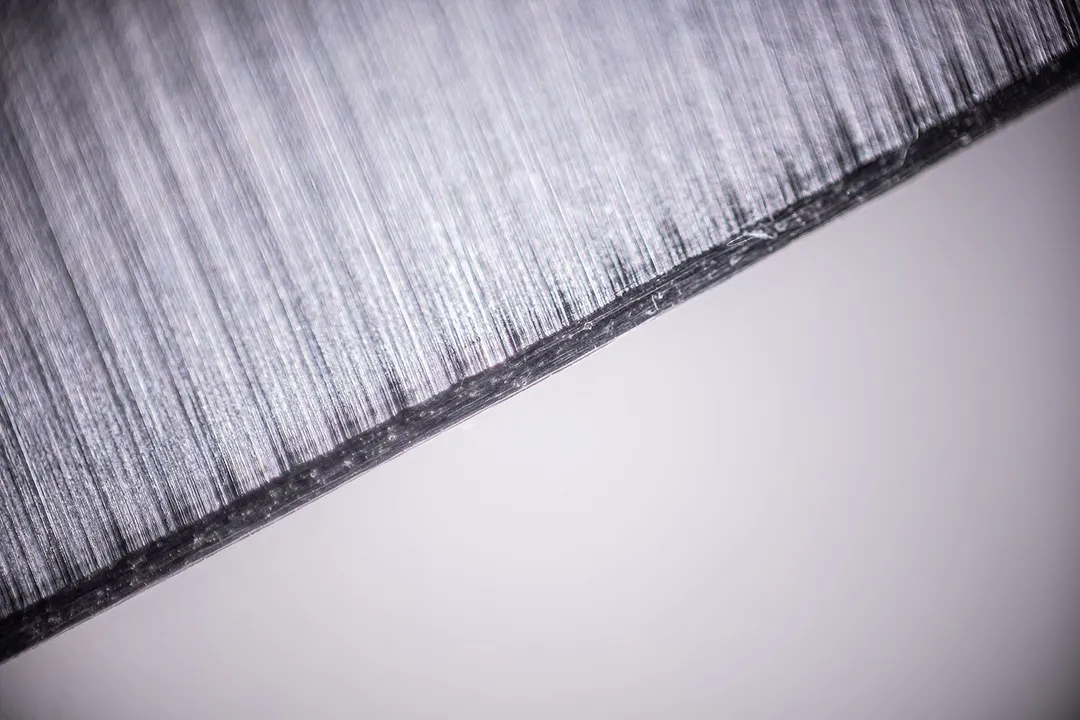
The KitchenIQ produces an ok edge with no major chips or burrs. The primary edge looks narrow, with visible horizontal grooves and tiny metal grains and fragments. The ceramic rods seem to do their job of refining the edge, making for better results compared to the Smith’s or SunrisePro.
8.1 Design
Other than the inadequate size, there’s nothing to complain about in the design of the KitchenIQ. The device is symmetrical, sturdy, and has a decent fit and finish. It’s smart, simple, versatile, and highly function-oriented.
In the Box
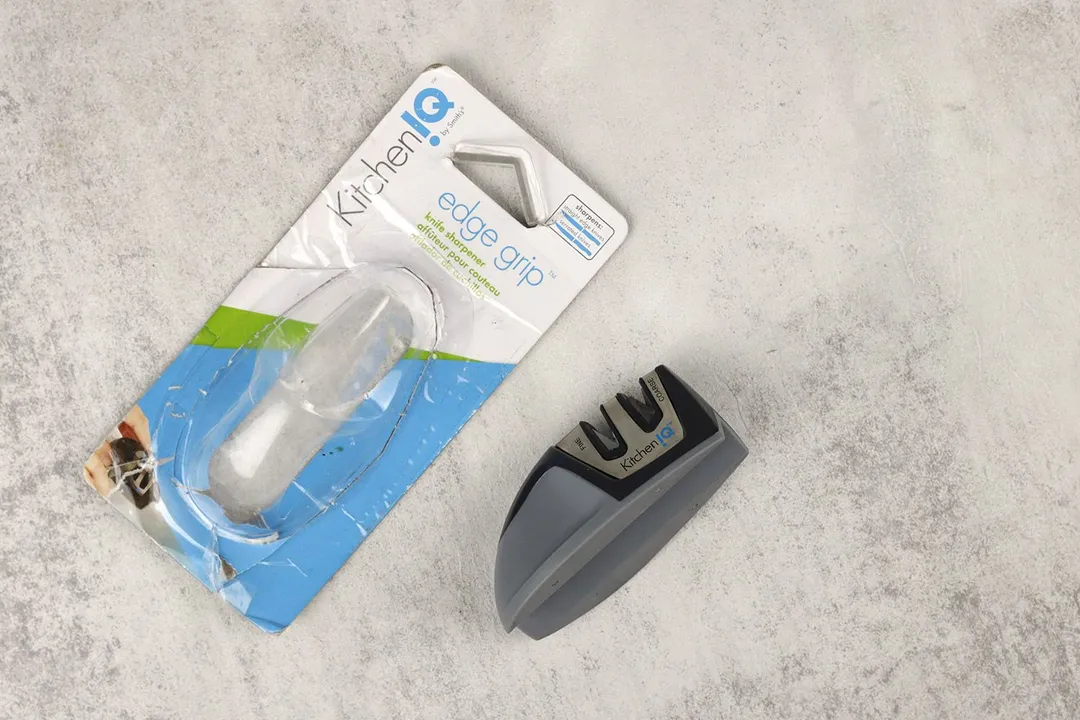
- The KitchenIQ 50009 edge grip knife sharpener
The device comes in a simple clamshell package. It has four color options. Interestingly, each color is sold at a different price, though they’re all affordable.
Dimensions

8.7 Build Quality

The KitchenIQ deserves a shoutout for its excellent build quality despite its cheap price. The whole sharpener is solid and sturdy. Its parts all fit together seamlessly, leaving no unexpected gaps. We actually dropped it from our countertop a couple times, and it took it well. Even afterward, we didn’t observe any rattling or loose components.
The silicone grip cover was nice to the touch and comfortable to hold throughout the sharpening session.
6.5 Grip

We really like the feel of the grip — it’s soft but offers good friction. It has an ergonomic shape and is connected directly to the base, thus offering great stability. Its tiny size, however, feels awkward in even smaller hands. Users with large hands will have problems finding a safe place for their fingers.
Working Section
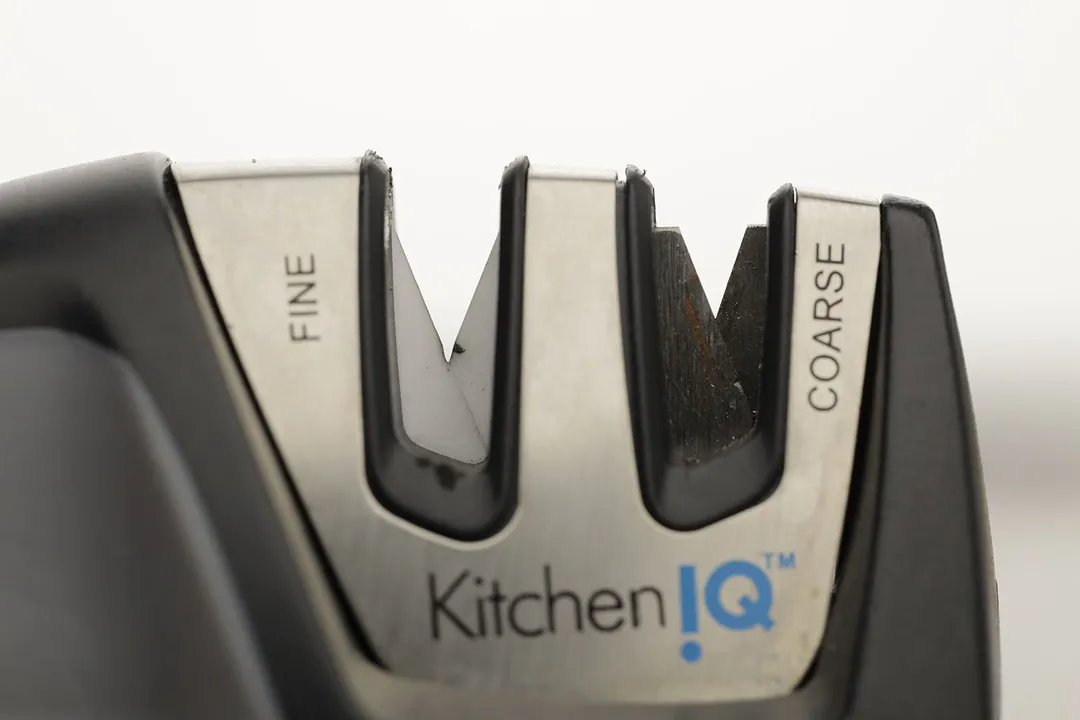


The KitchenIQ offers two levels of sharpening. While the slots themselves are more or less the same size as those on other devices, the whole working section is rather small and doesn’t work well with larger and thicker knives.
Base

Not only is the layout of its working section different from most other devices, the KitchenIQ’s base is special too. It’s a thick silicone pad that covers the grip and extends all the way to the base, creating lots of friction with any flat surface. The cutout in the middle of the base forms an edge grip, allowing you to attach it to the countertop or table edge (as long as that edge is 90 degrees).
8.2 Ease of Use
With only two sharpening slots and a basic design, it doesn’t require a high IQ to understand how the KitchenIQ works. The device’s small size may, however, mean you have to pay extra attention every time you use it or risk hurting yourself by misplacing the knife.
7.0 Slot Arrangement

The KitchenIQ employs a different slot layout than most others of its type: The coarse slot is placed further from the grip than the fine one. If you’ve used other pull-through sharpeners before, this layout will take some time to get used to. Otherwise, it’s not a problem: The slot names (Coarse and Fine) are printed on both sides of the working section, so pay a little attention and you’ll do it right. This also makes the device south-paw friendly.
7.0 Insertion

You may notice that the tungsten blades in the Coarse slot have distinct corners that protrude from the plastic frame. If you use too much force or are too fast with insertion, your delicate knife edge may end up raking across one of those surfaces and risk chipping or deforming.
Also, the tiny size of the KitchenIQ means the slots are jammed together and are very close to the grip. There’s a real danger of cutting yourself if you’re not mindful while sharpening your knives.
All that being said, insertion was not challenging. We measured the actual openings and found to our surprise that they’re some of the widest among all the devices we tested (6mm).
7.0 Pulling Through
The KitchenIQ’s sturdy working section and strong base allows for steady operation. Pulling through was effortless, though it’s easy to cut into the plastic frame underneath the sharpening panels if you go too fast.
We noticed that the ‘brace’ is rather loose on this device — the sharpening rods don’t seem to grip to the blade very tightly. This contributes to the rather mediocre sharpening performance.
10 Stability on a Clean Surface

With a grip and base made from one solid piece of tough silicone, the KitchenIQ stood perfectly still on a clean countertop as we pulled a knife through it. It has a low center of gravity, so regardless of the force used, the device didn’t wobble one bit.
We tried it on the countertop edge, too, which it’s designed to work on, and were happy with how well it gripped the edge.
7.0 Stability on a Wet and Dirty Surface
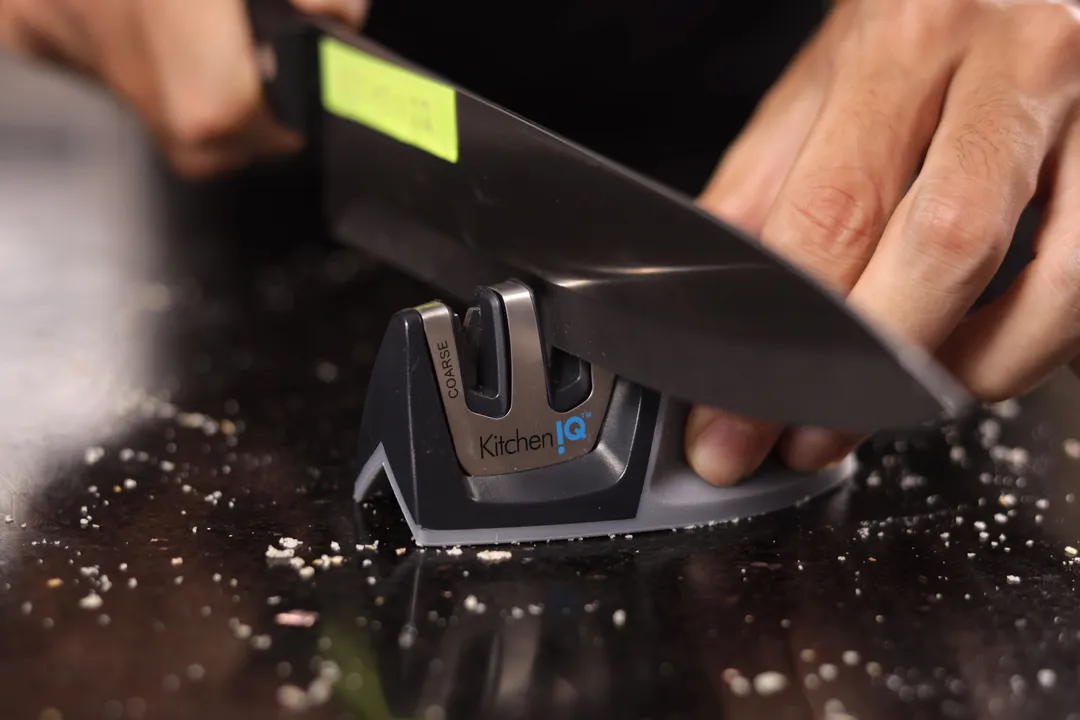
Like most other devices, the KitchenIQ’s silicone base couldn’t keep it in place on a dirty countertop. To its credit, the device slid but did not shake or wobble like the taller units we tested. Still, given how its grip is so close to the sharpening slots, you run the risk of cutting yourself if things slip.
The same was observed on a wet and slippery edge: no wobbling, but the silicone foot doesn’t help much in keeping it from gliding along the edge.
Behind the review
Anh Ngo is a writer with 9 years experience at different media outlets, covering from public news and events to product testing and analysis. At HealthyKitchen101, she works across different departments, communicating closely with its network of writers, editors, and health, tech, and search engine experts to provide a meaningful and pleasant reading experience for visitors.
Lap is Head of the Research, Testing, and Review Team (RTR Team) at HealthyKitchen101.com, where he directs and supervises the testing of kitchen gadgets and appliances.
Nguyen Ntk is a graphic designer, photographer, and videographer whose philosophy centers around respecting and celebrating the beauty of reality. Through his lenses, Nguyen strives to capture the true essence of objects and events, showcasing and highlighting authentic features without distortion or exaggeration.


